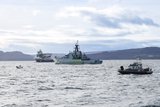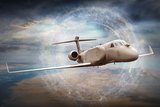Navigating the Waters of Modern Warfare: The Role of Maritime Unmanned Aerial Systems
This article is brought to you by Aeronautics
They are designed to implement in the field advanced capabilities developed such as scanning and monitoring vast maritime domains and ensuring mission success in a challenging naval environment. Moreover, this technological progress drives a significant leap in the Naval force's organic intelligence gathering and operational efficiency.
According to Captain (Reserve) Yoav Abergel, a naval strategist and Director of Marketing and Business Development at Aeronautics, the integration of advanced MUS capabilities marks a breakthrough in maritime operational efficiency and combat effectiveness. He emphasizes the latest maritime version of Aeronautics Orbiter 4 that integrates VTOL capability is an excellent example of an autonomous Tactical UAS that enhances mission operability, enabling adaptation to multi-mission profiles and ensuring maximum flexibility for commanders in the field.
Aeronautics was recently selected and signed an important naval contract for the Aeronautics Orbiter 4, underlining the growing recognition of its capabilities in the maritime domain.
Unparalleled Endurance and Operational Reach
The new generation of small tactical Maritime Unmanned Aerial Systems (MUAS) represents a transformative phase in maritime surveillance, intelligence and detection capabilities. Aeronautics' Orbiter 4 Small Tactical Unmanned Aerial System (STUAS), equipped with a Vertical Takeoff and Landing (VTOL) kit, emerges as a solution that addresses current challenges.
Its exceptional endurance, exceeding 12 hours of operational time, coupled with a versatile payload variety and an impressive range of up to 120 kilometers (around 65 nautical miles), along with precise landing capability enable naval forces to access advanced and robust capabilities. The Orbiter 4 VTOL can overcome C5I challenges while gaining operational advantages, including long endurance ISR, situational awareness, enhanced situational awareness, and anti-surface warfare missions.
Maximizing Operational Efficiency and Flexibility
The seamless integration of the Orbiter 4 VTOL onto existing ship systems not only makes it part of the generated solution but also enhances operational simplicity through automation. This integration streamlines mission planning and execution, significantly reducing the logistical footprint compared to traditional naval helicopters.
The flexibility of deploying the Orbiter 4 MUAS on missions typically undertaken by helicopters offers the best tactical solution, ensuring operational efficiency and cost-effectiveness. The MUAS enables simpler logistics, with the use of a small operation team, field level technical support, and an optimized operation envelope, further emphasizing its advantages in terms of operational efficiency and logistical ease over conventional helicopter operations.
More from Industry Spotlights
-
![“A new philosophy of defence”: ASELSAN sets out ambitions for the future]()
“A new philosophy of defence”: ASELSAN sets out ambitions for the future
In Conversation: Shephard’s Gerrard Cowan talks to ASELSAN CEO and President Ahmet Akyol about how the business has evolved and expanded over the past five decades, and its aim of becoming a top 30 global defence company by 2030.
-
![Levelling up – how autonomous fire control tackles unmanned lethality head-on]()
Levelling up – how autonomous fire control tackles unmanned lethality head-on
As autonomous weapon systems proliferate, it is now essential to use the same core technologies to counteract and neutralise them.
-
![Evolving for the future fight]()
Evolving for the future fight
Built on a 60-year heritage of providing the Department of Defense with solutions to dominate the electromagnetic spectrum.
-
![How AI and robotics drive innovation in land-based defence]()
How AI and robotics drive innovation in land-based defence
The future on the frontlines: automation and AI isn’t just about improving efficiency or driving down labour cost - for Pearson Engineering it’s everything.
-
![How satcom is shaping the future of fast, accurate warfare (podcast)]()
How satcom is shaping the future of fast, accurate warfare (podcast)
"Speed is the key advantage and accuracy is the key outcome": Amazon Kuiper Government Solutions’ Rick Freeman talks to Shephard’s Georgia Lewis about how space-as-a-service is transforming defence connectivity and access to satellite capabilities.
-
![How do land and air defense forces defend against complex threats?]()
How do land and air defense forces defend against complex threats?
Learn how RTX systems defend against complex attacks from adversaries including hostile drones, and multi-range missiles.

























